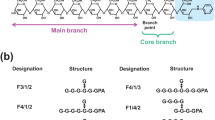Abstract
Hexokinase II prepared from Ehrlich-Lettre hyperdiploid tumor cells (ELD cells) was subjected to a limited digestion by trypsin. After 60 min digestion, hexokinase II (100 kDa) was completely cleaved to two fragments with the molecular weight of about 60 kDa and 40 kDa as manifested in SDS-PAGE. It was noteworthy that the enzyme activity was observed even at the time when the native enzyme molecule was no more detectable. These fragments were separated by SDS-PAGE irrespective of the presence of a reducing agent, but neither by native PAGE nor by cellulose acetate membrane electrophoresis under the nondenaturing conditions. Neither kinetic parameters such as Km values for ATP and glucose nor an ability of binding to mitochondria were changed significantly by the tryptic digestion. These results indicate that an essential conformation of hexokinase II can be restored by the self-association of two fragments produced as a result of the cleavage by trypsin at the middle of the molecule. Affinity labeling with 2′-3′-dialdehyde ATP followed by the trypsin digestion showed that ATP binding site resided in the 40 kDa fragment. Furthermore, the mode of the response in the incorporation of this ATP analog to hexose phosphate, moreover, was similar to that in the catalytic activity.
Similar content being viewed by others
Abbreviations
- SDS:
-
Sodium Dodecyl Sulfate
- PAGE:
-
Polyacrylamide Gel Electrophoresis
- EDTA:
-
Ethylenediamine Tetraacetic Acid
- CBB:
-
Coomassie Brilliant Blue
- PMSF:
-
Phenylmethylsulfonyl Fluoride
- TPCK:
-
N-tosyl-Lphenylalanyl Chloromethyl Ketone
- ELD cells:
-
Ehrlich-Lettre Hyperdiploid Tumor Cells
References
Wilson JE: Regulation of mammalian hexokinase activity. In: R Beitner (ed.) Regulation of Carbohydrate Metabolism, Vol. 1. CRC Press, Inc., Boca Roton, 1985, pp 45–85
Rose IA, Warms JVB: Mitochondrial hexokinase. Release, rebinding and location. J Biol Chem 242: 1635–1645, 1967
Kurokawa M, Oda S, Tsubotani E, Fujiwara H, Yokoyama K, Ishibashi S: Characterization of hexokinase isoenzyme type I and type II in ascite tumor cells by an interaction with mitochondria membrane. Mol Cell Biochem 45: 151–157, 1982
Kurokawa M, Yokoyama K, Ishibashi S: Polyamines stimurate the binding of hexokinase type II to mitochondria. Biochem Biophys Acta 759: 92–98, 1983
Imai N, Akimoto H, Oda M, Okazaki H, Ishibashi S, Kurokawa M: Interaction between cations in modifing the binding of hexokinase I and II to mitochondria. Mol Cell Biochem 81: 37–41, 1988
Kurokawa M, Yokoyama K, Kaneko M, Ishibashi S: Difference in hydrophobicity between mitochondria-bindable and non-bindable forms of hexokinase purified from rat brain. Biochem Biophys Res Commun 115: 1101–1107, 1983
Grossbard L, Schimke RT: Multiple hexokinase of rat tissues: Purification and comparison of soluble form. J Biol Chem 241: 3546–3560, 1966
Polakis PG, Wilson JE: Proteolytic digestion of rat brain hexokinase: Determination of the cleavage pattern during limited digestion with trypsin. Arch Biochem Biophys 234: 341–352, 1984
Nemat-Gorgani M, Wilson JE: Rat Brain hexokinase: Location of substrate nucreotide binding site in a structural domain at C-terminus of the enzyme. Arch Biochem Biophys 251: 97–103, 1986
Schirch DM, Wilson JE: Rat brain hexokinase: Location of the substrate hexose binding in a structural domain at the c-terminus of the enzyme.
Polakis PG, Wilson JE: An intact N-terminal sequence is critical for binding for rat brain hexokinase to mitochondria. Arch Biochem Biophys 236: 328–337, 1985
Bradford MM: A rapid and sensitive method for the quantification of microgram quantities of protein utilizing the principle of protein-dye binding. Anal Biochem 72: 248–254, 1976
Laemmli UK: Cleavage of structural proteins during the assembly of the head of bacteriophage T4. Nature 227: 680–685, 1970
Ureta T, Smith AD, Wilson JE: Hexokinase A from mammalian brain: Comparative peptide mapping and immunological studies with monoclonal antibodies. Arch Biochem Biophys 246: 419–427, 1986
Schwab DA, Wilson JE: Complete amino acid sequence of rat brain hexokinase, deduced from the cloned cDNA, and proposed structure of a mammalian hexokinase. Proc Natl Acad Sci USA 86: 2563–2567, 1989
Thelen AP, Wilson JE: Complete amino acid sequence of the type II isozyme of rat hexokinase, deduced from the cloned cDNA: Comparison with a hexokinase from Novikoff ascite tumor. Arch Biochem Biophys 286: 645–651, 1991
Nishi S, Seino S, Bell GI: Human hexokinase: Sequence of amino- and carboxyl-terminal halves are homologus. Biochem Biophys Res Commun 157: 937–943, 1988
Esterbrook-Smith SB, Wallace JC, Keech DB: Pyruvate carboxylase affinity labeling of the magnesium adenosine triphosphate binding site. Eur J Biochem 62: 125–130, 1976
Lowe PN, Beechey RB: Interaction between the mitochondrial adenosine 5′-triphosphate and periodate-oxidized adenosine 5′-triphosphate, and affinity labeling for adenosine 5′-triphosphate binding site. Biochem 21: 4073–4082, 1982
Gregory MR, Kaiser ET: Interaction of phosphofructokinase by dialdehyde-ATP. Arch Biochem Biophys 196: 199–208, 1979
Author information
Authors and Affiliations
Rights and permissions
About this article
Cite this article
Okazaki, H., Takebayashi, Y., Ando, M. et al. Cleavage of hexokinase II to two domains by trypsin without significant change in catalytic activity. Mol Cell Biochem 117, 87–92 (1992). https://doi.org/10.1007/BF00230414
Received:
Accepted:
Issue Date:
DOI: https://doi.org/10.1007/BF00230414




